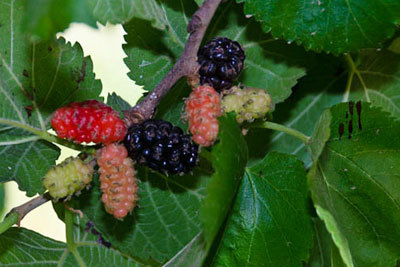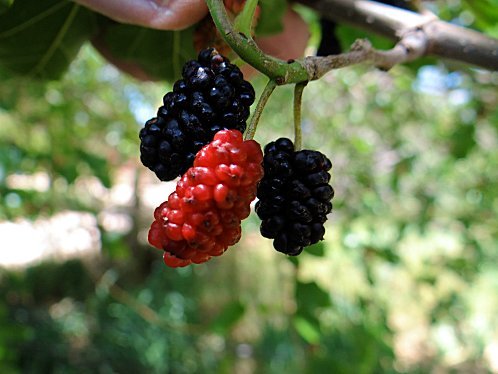The morace family Moraceae - Wikipedia as many of you are aware are plants such as osage orange, figs, mulberry, che and the full list can be seen here Moraceae — The Plant List. Morus is a sub family and rubra and alba are plants within that sub type as an example that are mulberries. Ficus is a category within Moraceae that is figs for example Ficus — The Plant List. The family is unique in many ways and if your breeding these plants there are things you should know in advance which is why i’m making the post. Fig seeds produce males and females as an example or sterile plants so a fig may never produce you grew from seed which if male my understanding is called caprifigs. Mulberries produce about 50% of the time male plants and are naturalized to this area see more at this link http://www.extension.iastate.edu/forestry/iowa_trees/trees/red_mulberry.html. See pictures of this family of fruits here http://www.botany.hawaii.edu/faculty/carr/mor.htm. The purpose of male and female plants is not always well understood because mulberry are reported by many experts to produce without male plants http://www.crfg.org/pubs/ff/mulberry.html. So how do you tell the males from female mulberry? See this link http://www.ehow.com/how_5862694_tell-mulberry-tree-male-female.html and description given here "
Male Flowers
Look closely at the flowers on a mulberry catkin. If it is a male catkin, the tiny, lime-green or yellowish-green flowers will be slightly purplish near their tips. On these tips are tiny filaments or stems bearing anthers.
You may have to use a magnifying glass to see the filaments and anthers clearly
Female Flowers
If you look closely at the tiny, pale-green flowers on a female mulberry catkin, you won’t see a filament, but you will see the stigma that curls outward from the tip of each flower. A stigma looks something like the curly horns on a sheep.
Using a magnifying glass may be necessary to see the stigma clearly. It’s possible to confuse a male anther with a female stigma. If a flower has no stemlike growth, which indicates a male filament, then you’re looking at a female flower". Sometimes I have seen male mulberries produce fruit. The better scenario might be to graft female mulberry scions to your male trees. By grafting the mulberry to change gender the male will now produce fruit. The ideal that all mulberry plants must be female is not something I follow either. If I have a good male plant I leave it because I believe it increases my crop though it doesn’t do much for my allergies. I’m making larger fruiting mulberry crosses now but using all wild stock.
in las vegas, males outnumber females(mulberries that is), primarily due to the ‘fear’ of pavements being stained purple. Sad that its high antioxidant content(reported by some experts to be higher than blueberries/blackberries), is the same thing which hoa’s want banned. I mean, the kardashians would find this quite filthy
especially if tracked indoors into their persian rugs and carpets, and that is understandable. Evidently, persian rugs and persian mulberries don’t mix.
It is just that most houses here have spacious yards where trees don’t need to be near concrete/houses, and considering that mulberries need negligible irrigation, no pesticides, and could bear fruits for hundreds of years(at least the morus nigra), children here are missing the nutritive value and fun of growing berries in their own backyards. If i were a parent with carpet floors, i’d have it pulled up and replaced with solid flooring just to accommodate
blueberries cost ~8$/lb and that’s quite a premium to many folks, but persian mulberries cost 20$/lb, and will be borne in great numbers on long-lived trees
i wish everyone will do that here…
What are sold as Persian Mulberry (Morus alba) originated in China and were brought to Persia along the Silk Road. The only mulberry native to ancient Persia is Morus nigra - the Mulberry bush.
For a definitive taxonomy of Moracea please see: https://npgsweb.ars-grin.gov/gringlobal/taxonomyfamily.aspx?id=735
Also note that although many species of Moracea are dioeceous, fruiting cultivars produced by commercial wholesale growers are typically self-fertile.
burntridgenursery and whitmanfarms.com do offer genuine persian mulberries(morus nigras), at least that am sure of.
Morus nigra fruits form directly on branch nodes

Morus alba, rubra fruits form on a stem

you got that right. The nigras have peduncles too, it is just that theirs are too short.
I believe they are offering the self-fertile hybrid.
all female mulberries(alba/rubra/nigra)are self-fertile, fruit-wise.
they are like hens, which can produce eggs without roosters.
Figs are really unique for a couple reasons. Caprifigs are actually hermaphrodite, but their female flowers host the fig wasp pollinator and are not edible. They can produce seeds but because the wasp larvae develop in most embryos the tree would get a raw deal (few seeds) if not for female figs.
Female figs have a different type of female flower, with a longer style that the wasp cannot lay eggs in, so all of the pollinated seeds develop.
The genes for short styled female flowers and stamens are supposed to be linked on the same chromosome. However there is a third class of fig with long styled female flowers and stamens, called edible caprifigs. So there is still some mystery surrounding the sexes of figs.
figs are quite intriguing, and odd!
a third oddity is that the ‘fruit’ that we eat is actually the inflorescence. Which is a specialized stem-flower structure.
a fourth oddity, or should i say–drawback, is that the inflorescence needs to be accessed by insects for pollination, and depending on variety, those with large ‘eyes’ through which insects may do their thing render the figs unsterile–inside and out.
I share your sentiments.
Nothing like eating a bowl of wild mulberries picked from the local park while standing inside on my home’s hardwood floors!
They inevitably stain my fingers. So what? I should be so lucky!
I think I read somewhere that mulberry trees in some Canadian city’s parks (Ottawa? Montreal? Toronto? I can’t remember) were under threat of felling because of sidewalk staining concerns. Others in the community cried foul; they want to keep the beautiful trees and the yummy fruit they produce.
exactly! Blueberries stain too, the only reason it doesn’t stain its surroundings too much is because we hardly get enough fruit from it(if at all, especially in areas with alkaline earth). Mulberries are extremely prolific, regardless of location, soil conditions, and cultivation /neglect it receives, and thus should not be ‘punished’ for its virtues!
shouldn’t be hard for city park planners/landscapers to plant them away from sidewalks, parking lots, and foot traffic(though surely, where there will be fruiting mulberries-- there will be foot traffic)
Guerrilla Grafters Secretly Graft Fruit-Bearing Branches onto San Francisco Trees
–“undoing civilization one branch at a time”…
Oikos tree crops offers a Saskatoon/serviceberry which was found because it stained nearby rocks blue.
I don’t have this one, though the description makes it sound particularly interesting.
Found as a seedling tree along the shores of Lake Superior where the fruit had created a large area of blue stained rocks. In my opinion this fruit is the best flavored of all the Amelanchier we have at our farm. -
Also, Oikos offers a morus Nigra that he reports is hardy to zone 5. I spoke with him and he knows his stuff well enough that I believe him… http://oikostreecrops.com/products/tree-crops/fruit-wood/black-mulberry/
Both the taste and juiciness of black mulberries, especially the nigra species, is much more worthwhile to grow compared to seedling mulberries you may commonly find. Usually the fruit is also larger reaching up to 4 inches long on some seedlings. At this point only the seedlings that survive at the farm location, zone 5-6 are used. Except for one grafted selection all of the other grafts we had died here and so we discontinued trying to produce our own seed from grafted varieties as these were developed from more ‘southern’ types. Now we are just starting to grow out the hardiest ones here and that is what we are offering for sale. -
Scott
I just picked up a large weeping mulberry at a local nursery. It was missing the label but in a Monrovia 10-gallon pot (for whatever that’s worth). I assume it’s Morus alba, and the plan is to graft some good fruit-bearing scions next spring. I gather from @clarkinks that even if the tree is male, grafting fruit-bearing scions will in fact, produce fruit of that variety. I’m curious, however, if the weeping habit will be expressed at all in the grafted scions? Imagine a straight, 6’ trunk, then a crown of arching, pendulous branches, then what? Will the scions tend to grow out, up or down? Has anyone tried to frankenstein a weeping mulberry?
Yes I have grafted weeping mulberry. The scion of normal mulberry grows straight up on weeping mulberry. It is in all cases I have seen the mulberry scion that does the weeping growth and not the rootstock. There have been friends who had the scion die and rootstock grew straight up. All that said if someone made a cutting of the scion portion of weeping mulberry to use as rootstock it’s possible it could influence weeping though I have never seen that. A word of caution in my environment the scion part of weeping mulberry is not overly hardy and dies leaving the hardy rootstock. If your grafting to a less hardy tree your scion that portion also dies. You are correct male mulberry can be grafted to female. After having said the rootstock does not influence the weeping in mulberries in my experience it does not mean that is necessarily always going to be true. Every weeping mulberry I have encountered seem to be made from scions from the same type of weeping mulberry. So you might ask why bring it up ? The answer is sometimes the rootstock has great influence over many things but its not typical. Just because that’s my experience does not mean someone has not developed a better weeping mulberry. Here is an example of rootstock influence on scion
One more question for you experienced mulberry growers - especially if you have wild mulberries in your environment:
How far away does a grafted female fruit-bearing tree need to be from any (wild) males? I understand that mulberry is wind-pollinated, and I also understand that all the fruits contain rudimentary seeds that are basically unnoticeable (like a blueberrry’s seeds) unless they are exposed to male pollen - at which time the seeds will swell and become noticeable and also become fertile. As a consulting horticulturist I want to give my clients good information, but I cannot find any reliable data on distance needed between male trees and female grafted varieties to keep the fruit “seedless” and infertile.

